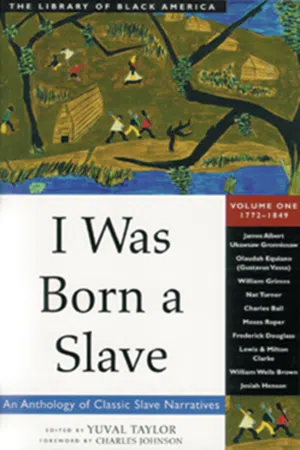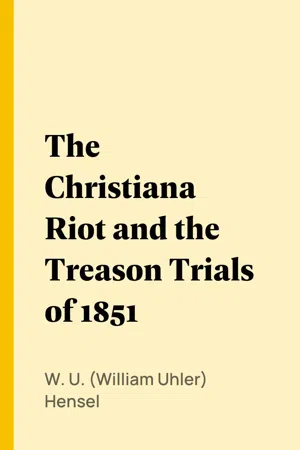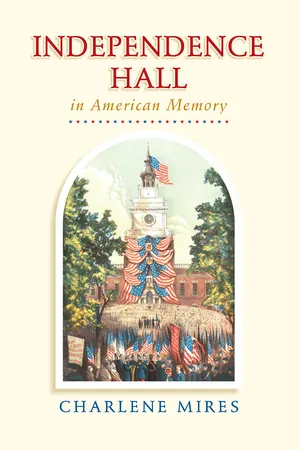History
Christiana Riot
The Christiana Riot was a violent clash between African American residents and slave catchers in Christiana, Pennsylvania in 1851. The incident was sparked by the arrival of slave catchers seeking to capture four fugitive slaves. The riot resulted in the death of one of the slave catchers and the trial and acquittal of 38 African Americans charged with treason.
Written by Perlego with AI-assistance
Related key terms
3 Key excerpts on "Christiana Riot"
- eBook - ePub
I Was Born a Slave
An Anthology of Classic Slave Narratives
- Yuval Taylor(Author)
- 1999(Publication Date)
- Lawrence Hill Books(Publisher)
I could not look upon them as murderers. To me, they were heroic defenders of the just rights of man against manstealers and murderers. So I fed them, and sheltered them in my house. Had they been pursued then and there, my home would have been stained with blood, for these men who had already tasted blood were well armed and prepared to sell their lives at any expense to the lives and limbs of their probable assailants. What they had already done at Christiana and the cool determination which showed very plainly especially in Parker, (for that was the name of the leader,) left no doubt on my mind that their courage was genuine and that their deeds would equal their words. . . . The hours they spent at my house were therefore hours of anxiety as well as activity. I dispatched my friend Miss Julia Griffiths to the landing three miles away on the Genesee River to ascertain if a steamer would leave that night for any port in Canada, and remained at home myself to guard my tired, dust-covered, and sleeping guests, for they had been harassed in traveling for two [actually eight] days and nights, and needed rest. Happily for us the suspense was not long, for it turned out that that very night a steamer was to leave for Toronto, Canada. . . .I remained on board till the order to haul in the gang-plank was given; I shook hands with my friends, received from Parker the revolver that fell from the hand of Gorsuch [the slaveholder who had come from Maryland to recapture his fugitive slaves] when he died, presented now as a token of gratitude and a memento of the battle for Liberty at Christiana, and I returned to my home with a sense of relief which I cannot stop here to describe. This affair, at Christiana, . . . inflicted fatal wounds on the fugitive slave bill. It became thereafter almost a dead letter, for slaveholders found that not only did it fail to put them in possession of their slaves, but that the attempt to enforce it brought odium upon themselves and weakened the slave system.2Back in Pennsylvania, federal prosecutors charged the rioters not only with resisting the Fugitive Slave Act of 1850, but also with treason. Thirty-six blacks and two whites were indicted and imprisoned in Philadelphia. Throughout the country, blacks raised money to defend the rioters, to make their imprisonment more comfortable, and to provide funds for their families. Because merely prosecuting blacks would not have mollified the South, Castner Hanway, a white man who had been present at the riot, was accused of having directed the blacks in their attack; his trial was to be a test case on which the fate of the other defendants would rest. Instead it became a farce. Hanway was handily acquitted, and the rest of the prisoners were released. As a whole, the riot and trial encouraged Northerners to resist enforcement of the Fugitive Slave Act, outraged Southerners, and moved the nation closer to civil war.3 - eBook - ePub
The Christiana Riot and the Treason Trials of 1851
An Historical Sketch
- W. U. (William Uhler) Hensel(Author)
- 2018(Publication Date)
- Perlego(Publisher)
Numerous attempts have been made to publish reports of this incident which would serve the purposes of permanent history; and, while they have all been helpful, none has been complete. On his return to Maryland after his failure to convict Hanway and the others of treason, Attorney General Robert J. Brent, of Maryland, made an elaborate official report to Governor E. Louis Lowe, who in turn submitted it, with extended comments of his own, to the General Assembly of Maryland, January 7, 1852. From the standpoint of the lawyer and the chief executive of a slave state, both are able deliverances. Aroused by their version of the affair, and especially by their comments on the treason trial, and impatient over the delay in publishing the official report of it, W. Arthur Jackson, junior counsel for the defendant, printed a pamphlet review of it, which shows much ability, has great value and has become very rare. The official phonographic report of the trial, by James J. Robbins, of the Philadelphia bar (King & Baird, 1852), is of course a copious fountain of exact information—as well as an interesting exhibit of the “reportorial” efficiency of that day. From all of these I have felt at liberty to draw largely.“A True Story of the Christiana Riot,” by David R. Forbes, 1898, tinged with sectional prejudice, has much matter that was well worthy of preservation, and the new facts it contains, if verified, I have freely used. All of the general political histories of the period refer to the Christiana tragedy as having significance in the intense agitation of the issue raised by the Fugitive Slave Law of 1850. Fred. Douglass’ stories of his life and time; William Still’s “Underground Railroad,” and Dr. R. C. Smedley’s “History of the Underground Railroad” have also been subjects of my levy for aid. To them, however, have been added the personal reminiscences of Dr. J. W. Houston, Thomas Whitson, Esq., Ambrose Pownall, Charles Dingee, Gilbert Bushong, Peter Woods, William P. Brinton, Cyrus Brinton and many other residents of the neighborhood in which the riot occurred and from which the prisoners in the trials for life were taken. Access has been had to the diaries and family records of the Pownall, Hanway, Lewis and Gorsuch families; and many other original sources of information, including the local and metropolitan newspapers of that day, whose enterprise and impartiality were somewhat variable. Some of them published full reports of the trial. - eBook - ePub
- Charlene Mires(Author)
- 2015(Publication Date)
- University of Pennsylvania Press(Publisher)
As dramatic and unnerving as the first fugitive slave cases were, they were preludes to the celebrated treason trial that followed the so-called “Riot of Christiana,” in which a Maryland slaveowner with the legally required warrants was killed while in pursuit of suspected fugitives in Lancaster County, Pennsylvania. In the aftermath of the confrontation on September 11, 1851, thirty-three blacks and five whites were charged with treason for interfering with the Fugitive Slave Law. Those who did not manage to escape arrest were taken to Philadelphia for trial. Charged with a federal offense, the defendants faced judge and jury in the second floor of the State House. The setting provided lawyers with the opportunity to link their arguments to the memory of the signers of the Declaration of Independence and the framers of the Constitution.Amid the sectional tension of the 1850s, the Christiana shootout drew national attention and unleashed public debate that resonated with the historic associations of the old Pennsylvania State House. Were the Christiana men defenders of liberty in the tradition of the Declaration of Independence? Or were they the worst sort of criminals, defying the authority of the Constitution by refusing to comply with the law? At the Pennsylvania Anti-Slavery Society’s annual meeting in West Chester, a speaker declared, “Those colored men were only following the example of Washington and the American heroes of ’76.”42 In Philadelphia, on the other hand, a mass meeting in Independence Square supported swift punishment of the Christiana defendants “to prevent the recurrence of so terrible a scene upon the soil of Pennsylvania, to ferret out and punish the murderers thus guilty of the double crime of assaulting the Constitution, and of taking the lives of men in pursuit of their recognized and rightful property.”43With one defendant, a white man named Castner Hanway, brought to trial first as a test case, panels of prominent attorneys assembled for the prosecution and defense. The team of five defense lawyers included Thaddeus Stevens, an antislavery activist and congressman from Pennsylvania. The seven prosecution lawyers included U.S. Senator James Cooper of Pennsylvania, the U.S. attorney of the Eastern District of Pennsylvania, and the attorney general of Maryland. On November 24, the first day of the trial, the National Era noted that “an immense crowd of blacks and whites blocked up the passage-way through Independence Hall, leading to the Court-room. At half past ten o’clock the doors were opened and the crowd rushed in, filling the room to suffocation.” In the course of the three-week trial, spectators included such prominent abolitionists as Lucretia Mott. At one session, twenty-four of Hanway’s alleged accomplices were brought to court so that one of them could be identified by a witness. To the disgust of the chief prosecutor, they wore red, white, and blue scarves around their necks, and black defendants sat with white female supporters.44
Learn about this page
Index pages curate the most relevant extracts from our library of academic textbooks. They’ve been created using an in-house natural language model (NLM), each adding context and meaning to key research topics.


